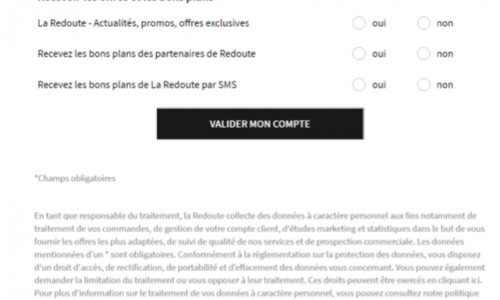Since its implementation in 2018, the General Data Protection Regulation (GDPR) has sparked both enthusiasm and concern among professionals. This regulation aims to standardize practices for collecting and using the personal data of your fans and visitors within the European Union. While GDPR emphasizes the importance of obtaining prior consent through Opt-In strategies, it's essential not to overlook the significance of Opt-Out mechanisms. In this article, we aim to provide clarity on both approaches.
Definition point
 L'OPT-IN refers to an email address for which prior consent has been obtained from the owner. This consent applies to the use of this address in a specific context. Consent may be obtained by written or electronic validation.
L'OPT-IN refers to an email address for which prior consent has been obtained from the owner. This consent applies to the use of this address in a specific context. Consent may be obtained by written or electronic validation.
L'OPT-OUT is a term used to describe addresses that are removed from mailing lists. They may opt-out automatically (this is known as passive opt-out), or manually (active opt-out).
While communication practices typically prioritize OPT-IN it is possible to communicate with an OPT-OUT. To explain this, we first need to analyze the purpose of your messages.
I - Distinguishing the nature of the message
Communication messages can be broadly categorized into prospecting and service/non-commercial messages.
Is defined as prospecting "the direct sending of any message intended to promote, directly or indirectly, goods, services or the image of a person selling goods or providing services". This type of communication corresponds to newsletters, as well as to the various types of promotional messages a company can send out. Promotion is here understood in a broad sense, so editorial newsletters and abandoned shopping cart follow-up emails are considered by default to require an OPT-IN.
In addition to this type of forward-looking message, advertisers may also send service messages of a non-commercial nature. Some of these, such as purchase confirmation emails or order tracking emails, may be required by law to fulfill the sales contract. It should be noted that an unclear legal vagueness exists with regard to email requests for feedback. Depending on the content and tone of the message, they may be considered as service emails (with no opt-in) or promotional (with opt-in).
II - Principle and exceptions

In principle, communicating with your audiences requires an OPT-IN, i.e. that they have explicitly consented to receive your communications..
There are two exceptions :
- The contact has already benefited from your services and your communication concerns similar products or services provided by the same person.
- Communication is essential to the success of the sales contract.
These are the only situations in which you can communicate with your OPT-OUT contacts.
III - How to collect OPT-IN?

a ) In the case of registration forms, consent to receive your communications must be clearly requested. The answer to this question may be mandatory.
Other advertisers make this option optional. But without a validatin, your contacts will be considered as OPT-OUT. You will only be able to send them promotional emails if they have made a purchase.
We recommend making this response option mandatory to simplify consent management.


b) The advertiser can also offer its audience the opportunity to opt-out of receiving communications by ticking a box. This is the default OPT-OUT. However, the advertiser may then only communicate if the prospect makes a purchase, in order to justify the use of the exceptions presented above.

c) Precise rules also govern the oral collection of consent as can happen at ticket counters and public reception points. For example, information setting out the purpose for which your visitors' data will be used must be read or displayed on site. You will then need to inform your audience that they will be able to access all the information and provide written consent. In the event of an audit, you'll need to keep the script spoken by the telephone operator.
d) Service emails sent to your customers OPT-OUT customers can be used as an opportunity to ask them to become OPT-IN by subscribing to your newsletters.
IV - What is the shelf life?
Your prospects' data cannot be kept indefinitely. The limit recommended by the CNIL is 3 years from the last action taken by your customer. Customers whose last contact is older cannot be reactivated. It should be added that the notion of last action by e-mail is governed by a number of legal precedents. Opening an email does not count, unlike a click.
As such, you need to think about implementing a strategy aimed at reactivating your older customers before they leave your database. Unsubscribing should be easy and, if possible, just a click away.
V - Our marketing tips
- You can use order confirmation emails to ask your opt-out contacts to subscribe to your newsletter. However, the subject line and main content of the email should remain the service email.
- You can then create welcome scenarios as soon as the person signs up. Explain in the emails why people are being contacted, and let them set their preferences : How many newsletters would they like to receive this month ?
- Regularly monitor your target statistics OPT-OUT. If your performance on this target is less than your overall performance, be less aggressive and opt for 100% editorial newsletters. On the other hand, if your performance is satisfactory, you can start including promotional emails.
To help you create marketing automation scenarios, we've created a training course you can join.